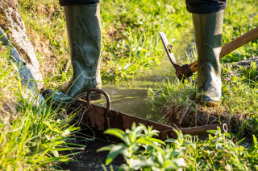Categories: knowledge and practices concerning nature and the universe; traditional craftsmanship; oral traditions and expressions; social practices, rituals and festive events.
States: Austria, Belgium, Germany, Italy, Luxembourg, the Netherlands and Switzerland

© SL-FP
Traditional irrigation is a type of agricultural irrigation that aims to ensure optimal crop growth. It relies on the strategic use of gravity and manually constructed systems such as channels and ditches to deliver water from naturally occurring sources (e.g. springs, streams and glaciers) closer to the fields. Based on different factors, practitioners choose specific times (often determined by specific regulations) to divert the water from the channels to the fields by digging small temporary ditches or damming the water to create an overflow. To use this method sustainably and efficiently, extensive knowledge of the landscape, water flow, and weather conditions is required, as well as close cooperation between those responsible for the distribution of the water (often farmers, landowners and volunteers) and others involved in the maintenance of the physical structures (such as water cooperatives, volunteers, local authorities and associations).
This form of irrigation is primarily used to moisten, fertilise and/or reinforce the soil, while guaranteeing, increasing and improving crop yields and quality. The skills needed for traditional irrigation practices, and the corresponding systems and irrigation tools are largely dependent on the natural environment. They can only function in combination with the related knowledge and guidelines that have been passed on orally and in written form over generations. To facilitate the division of tasks and the distribution of water throughout the year, bearers and practitioners have developed written regulatory systems. These written rules, which set out guidelines adapted to the local conditions, are known in different regions as ‘Road/Rods’, Wasserbriefe (water letters), ‘bulletins’, Kehrordnungen (sweeping regulations) and/or Wasserregister (‘water registers’). This complex practice can only function through close cooperation and the sharing of knowledge and experience between all stakeholders (farmers, volunteers, institutions, associations) in all tasks, such as the maintenance of waterways, planning the watering schedule and the division of water quantities.
Traditional irrigation methods can be applied both in low-lying and mountainous terrain. While the practices are similar, they are adapted to the natural conditions of each region. Different forms of craftsmanship are necessary to carry out the practice, for example knowledge of carpentry to build water wheels and expertise to forge the water irons. Traditional irrigation is a community-based, sustainable, adaptable way of supplying water for agriculture that does not require energy and respects biodiversity. It is very important to practitioners themselves and the wider communities of people who contribute to or benefit from its environmental impact.
The multinational nomination ‘traditional irrigation : knowledge, technique and organisation’ is coordinated by Austria and involves seven countries, including Switzerland. This nomination aims to highlight the traditional irrigation and water management models, particularly through consortages – historic cooperatives that manage a common good in a local and participatory manner.
In Switzerland, the project involves the Wässermatten (irrigated pastures) of Oberaargau in the cantons of Bern and Lucerne, and the water channel cooperatives of Valais (Oberwalliser Sonnenberge, cooperatives of Ayent, Lens, Trient, Nendaz and Grächen).
On 6 December 2023, the 18th session of the Intergovernmental Committee for the Safeguarding of the Intangible Cultural Heritage in Kasane (Botswana) inscribed ‘traditional irrigation: knowledge, technique and organisation’ on the Representative List of the Intangible Cultural Heritage of Humanity.
Press releases
This content is available in German, French and Italian. Please select DE, FR or IT at the top right-hand corner of this page.
Documents
Links
The tradition in detail on the list of Switzerland’s living traditions
Associated traditions
In parallel to the preparation of the nomination file for UNESCO, the corresponding files and entries on the list of Switzerland’s living traditions are also adapted as part of the regular update of the inventory. This work is done in collaboration with the stakeholders concerned.
Additional links
Last modification 06.02.2024
Contact
Federal Office of Culture
Section Culture and society
Julien
Vuilleumier
Hallwylstrasse 15
3003
Bern
Phone
+41 58 467 89 75





